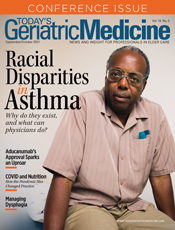
September/October 2021
Medication Monitor: Prescription Drug Overdose in Older Adults Prescription drug overdose is more common among the older adult population than is generally known. As people age, they tend to take more medications, which can lead to adverse drug events or even unintentional drug overdose. Adults aged 65 and older are nearly seven times more likely to be admitted to the hospital due to adverse drug reactions than did younger adults.1 Moreover, due to issues such as chronic pain, older adults are often prescribed pain killers, including opioids. Older adults who use opioids, regardless of whether they are dependent, are 15 times more likely to overdose than their peers who do not use opioids.2 Not only do opioids confer a high risk of dependency but they also can interact negatively with other drugs. It’s imperative for health care providers to address this issue with health programs that can assist with medication management and provide education regarding risks and behaviors that may lead to prescription misuse and overdose associated with these drugs. Theoretical Framework Developed in the 1950s by psychologists working for the US Public Health Service, the HBM attempts to understand why people don’t accept preventive measures for health care issues, such as screening for asymptomatic diseases. Later research applied the model to patients’ responses to symptoms and adherence to prescription regimens.6 The HBM is based on a person’s beliefs regarding health risks and whether a behavior is worth the risk to their health. The model was developed to study health behaviors and to explain why people do or don’t use available public health services related to prevention.7 This model is frequently used to help explain individuals’ health behaviors and develop insight into the underlying perceptions regarding the susceptibility of contracting a disease and the serious impact that disease might have on their health.6,8 Health Beliefs An individual’s perception of a disease influences the seriousness of attitude they take toward a disease and thus their health behaviors, the less healthful of which could pose a real threat and increase their risk of developing the disease. To be motivated to avoid risks associated with a disease, individuals must believe that the benefits of changing disease-related health behaviors far outweigh the effort needed to overcome barriers to those behaviors.3 When it comes to prescription drugs, a person’s belief that “more medication is better” or that it’s acceptable to take someone else’s medicine can greatly influence attitudes toward following recommendations. On the other hand, addiction anxiety can contribute to medication nonadherence. With older adults, these seemingly disparate perceptions about medication management actually can combine to contribute to behaviors that can lead to prescription drug overdose.9 The challenge for health providers is to develop medication management and education interventions and programs that will help stop and prevent prescription drug overdose. Perceived Benefits and Barriers to Medication Adherence However, some older adults think that if one pill is good for a condition, then two pills must be even better. This perception and behavior could place them at risk of drug overdose. With education about on side effects and the importance of taking medications as prescribed, older adults can make educated medication choices that will help prevent unintentional drug overdose. If older adults believe that taking medications as prescribed will prevent drug overdose, it’s more likely that they will take their medicines appropriately. Perceived Barriers Perceived Susceptibility and Severity Cues to Action For older adults who are aware of the risk of drug overdose due to medication nonadherence or misuse, cues to action can help prevent adverse events. Behaviors such as taking medications as prescribed, only taking prescribed medications, making regular visits to the doctor, learning about side effects prior to starting a medication, and encouragement from family and friends can all be cues to action toward good medication management. Another cue to action is to utilize a pill sorter to avoid medication mistakes. These steps can help older adults manage pain, avoid prescription drug overdose, and stay healthy. Summary — Rene’ Wren, OTD, OTR, BCG, is a core faculty member at the University of St. Augustine for Health Sciences in Dallas. Wren is American Occupational Therapy Association Board Certified in Gerontology. In addition to her role as instructor, she is a practicing occupational therapist of 20 years working primarily with the geriatric population in the skilled nursing facility and home health settings.
References 2. Larney S, Bohnert ASB, Ganoczy D, et al. Mortality among older adults with opioid use disorders in the Veteran’s Health Administration, 2000–2011. Drug Alcohol Depend. 2015;147:32-37. 3. Theory of reasoned action and theory of planned behavior. In: Hayden J. Introduction to Health Behavior Theory. 3rd ed. Burlington, MA: Jones & Bartlett Learning; 2019:36-58. 4. Herrmann A, Hall A, Proietto A. Using the Health Belief Model to explore why women decide for or against the removal of their ovaries to reduce their risk of developing cancer. BMC Womens Health. 2018;18(1):184. 5. Motavali ZS, Abedi H, Davaridolatabadi E. Self-medication and its effective modifiable factors among elderly referred health care centers in Shahr-e-Kord in 2015. Electron Physician. 2016;8(11):3205-3213. 6. Janevic MR, Connell CM. Individual theories. In: Hilliard ME, Riekert KA, Ockene JK, Pbert L, eds. The Handbook of Health Behavior Change. 5th ed. New York, NY: Springer Publishing; 2018:3-24. 7. Office of Behavioral and Social Sciences Research; Department of Health and Human Services; National Institutes of Health. Social and behavioral theories. https://obssr.od.nih.gov/wp-content/uploads/2016/05/Social-and-Behavioral-Theories.pdf. Accessed March 23, 2021. 8. The Health Belief Model. Rural Health Information Hub website. https://www.ruralhealthinfo.org/toolkits/health-promotion/2/theories-and-models/health-belief. Accessed March 23, 2021. 9. Benshoff JJ, Harrawood LK, Koch DS. Substance abuse and the elderly: unique issues and concerns. J Rehabil. 2003;69(2);43-48. 10. Misuse of prescription drugs research report. National Institute on Drug Abuse website. https://www.drugabuse.gov/publications/misuse-prescription-drugs/overview. Published June 2020. Accessed March 23, 2021. 11. Brown DA. Principles of pain management in the elderly. US Pharm. 2007;32(6):HS33-HS37. |
